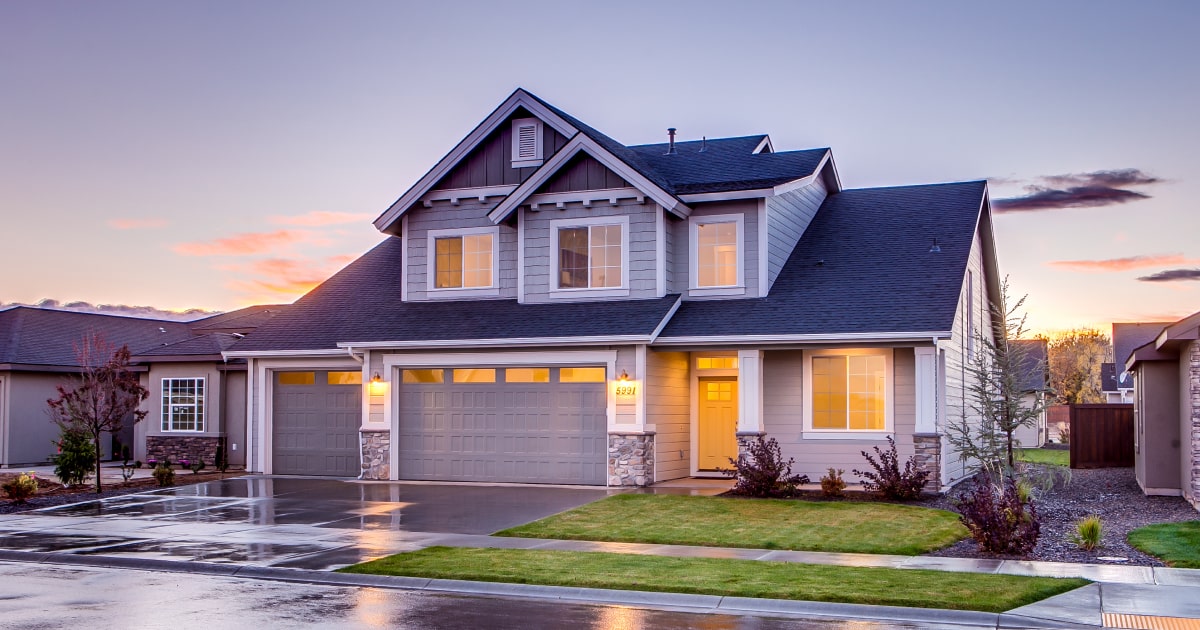Refinancing could save you money in the long run if you know when and how to do it
Homeowners tend to Refinance their mortgage to either access their equity or lower their monthly payments. This happens by changing the term or type of loan or removing mortgage insurance.
Once you’re sure you can lower your interest rate it may be time to look into refinancing. Still, other factors like your break-even point, budget, and personal circumstances should influence your decision too. In this article, we’ll explore the factors that go into deciding whether or not to refinance your mortgage and the benefits—and drawbacks—refinancing can offer.
What does it mean to refinance?
When you refinance your home, you essentially take out a new mortgage to replace your current one to lower your interest rate, get a lower monthly payment, or access equity. You can accomplish this when mortgage interest rates lower, you’ve paid off more than 20% of your home’s current value, your financial situation improves or your credit score goes up, or by changing the type of mortgage or the length of the loan term.
Lenders typically require a borrower to wait six to 12 months after getting their original mortgage to begin the refinance process.
When you refinance your mortgage, you’ll have to go through the same or similar process you did when you initially applied for a mortgage. You’ll pay origination fees, undergo a title search, and credit check, and wait for an appraisal. That’s because, just like your original mortgage, how much you’ll be qualified to receive and at what rate largely depends on the value of your home and your creditworthiness.
Closing costs vary but usually end up between 3-6% of the loan’s principal amount, and in most cases you can roll the costs into the refinance amount instead of paying them in cash at closing.

How do the interest rate and loan term affect your payments?
Generally speaking, the longer the term of your loan, the more you’ll pay in interest over the life of your loan, but the lower your monthly payment will be. To determine what’s better for you, consider how long you intend to stay in the home, how much you can comfortably pay each month, and what your break-even point is, which we’ll explain below.
A 15-year fixed-rate mortgage will come with a higher monthly payment but you’ll end up paying less after the full term than with a 30-year fixed-rate mortgage since you’ll be paying for a shorter period. The opposite is true of a 30-year fixed-rate mortgage, which usually comes with a slightly higher interest rate and a larger overall cost, but lower monthly payments since the interest is spread out for a longer period.
After you refinance, how much you’ll pay each month will ultimately depend on your new term and loan amount. Understanding how all of these things are related will help you when it’s time to decide whether or not to refinance—and what mortgage product to apply for.
We break down your monthly payments and your total loan costs here:
| Purchase price | Down payment | Total loan amount | Loan Term | Interest rate | Monthly payment* | Total interest over the life of the loan | Total paid over the life of the loan |
| $300,000 | $60,000 | $240,000 | 15-year loan | 4.9% | $1885.43 | $99,376.70 | $339,376.70 |
| $300,000 | $60,000 | $240,000 | 30-year loan | 5.6% | $1377.79 | $256,004.24 | $496,004.24 |
*Monthly payment does not include property taxes, homeowners insurance or HOA fees
What is the break-even point?
When you choose to refinance, it may be hard to decide which kind of mortgage to choose. One simple but important calculation you can make to see if—and when—your refinance will be worth it is to find the break-even point.
Since you will pay closing costs on your refinance (just like you did with your initial mortgage), the break-even point is when the amount you save each month adds up to the upfront cost of refinancing your mortgage. Ask yourself: how long would it take me to save, with these new rates, the same amount that I would spend on closing costs for my new mortgage?
For example, if your cost for a refinanced $300,000 mortgage is 3% ($9,000), and your monthly savings are around $150 per month, it’ll take you around 45 months’ worth of savings to make back your $9,000.
These numbers are simplified and don’t take into consideration other fees and costs like property taxes and private mortgage insurance but the idea is the same. If your break-even point is years away but you don’t plan to stay in the house the whole time, it may not be worth it. But if you’re refinancing to lower your monthly payments for the life of a 30-year loan, a 4-year break-even point may be a great deal.
6 reasons you may want to refinance
1. To lower your interest rates
Interest rates fluctuate over time. When they go down, you may be able to lock in that lower rate with a refinanced mortgage. That means you’ll have a lower monthly rate and will ultimately pay less by the end of the loan term than if you kept the higher interest rate of your original mortgage.
For instance, in 1981, 30-year fixed-rate mortgages reached a peak of 18.63%. Two years later, they were down to 12.59%, and four years after that, in 1987, they fell to 9.03%. If you bought a home in the first part of that decade and then refinanced at the end of the decade, you would have cut your interest rate in half.
Similarly, in 2020, after the onset of the COVID-19 pandemic, interest rates on 30-year mortgages plunged to 2.65% from the previous high of 4.94% in 2018. Now, 30-year fixed-rate mortgages have risen to 5.81% with more rate hikes possibility.
Mortgage rates will generally rise and fall with the overall economy so it is always hard to predict where they will be in the future. That’s why lenders often suggest that if you have the money to buy a home and can afford the initial payments, it may be cheaper to lock in rates now and plan to refinance later. You can wait for rates to drop before you buy but they may just keep going up instead for a few years.
You can use an online refinance calculator to see how lowering your interest rate could reduce your monthly mortgage payment and how much it could save you over the life of the loan.

2. You’ve raised your credit score
Your credit score affects the interest rate that you can get on a mortgage. If you took out your existing mortgage when your credit score was lower and have since raised your score, you can look into what a new interest rate might be. It’s still important to run the numbers to see where your break-even point is between what you’re paying in costs and what you’re saving in the long run.
3. You want a shorter home loan term
If you initially took out a 30-year mortgage with a higher interest rate and now want to reduce the loan term to a 15-year loan, refinancing is the way to do it. A benefit of a shorter-term loan is the interest rate will likely be lower.
Even if overall interest rates have stayed the same or risen since you took out your initial mortgage, you may still be able to lower your refinance interest rate by reducing the term of your loan. This strategy could raise your monthly payment but result in paying off your loan faster and reducing the amount of total interest you will pay.
4. You want to change the type of home loan
In the world of mortgages, there are different loans to choose from Conventional, FHA, VA, USDA, fixed-rate, and adjustable-rate mortgages (ARM). Each one comes with its requirements, advantages, and disadvantages. If you decide that you want to change the type of loan you have after reviewing the pros and cons, refinancing is the way to do it.
5. You need, or want, some cash
The difference between how much you still owe on your home loan and how much your home is worth right now is your equity. As you pay down your mortgage and owe less and less than what the home is worth, your share of the equity grows. So, if you owe $250,000 on a home that is valued at $300,000, you have $50,000 in equity. You could sell your home, pay back what you owe, and after closing costs keep some of the $50,000. Or, you could refinance to access the $50,000 and stay in your home at the same time.
There are two ways to access equity in a refinance:
Cash-out refinance
If you need, or want, some cash to cover bills, take on home repairs or upgrades, pay off debt, plan a wedding, pay tuition, or even go on a vacation, you can apply for a cash-out refinance. You’ll refinance into a new mortgage for the amount the home is worth right now (depending on the maximum loan amount allowed by your lender) and at closing you’ll receive a check for the available equity.
So, assume that you bought your home with a $300,000 loan and have since paid back $100,000 of the loan principal. You now owe $200,000. But let’s say the home has increased in value to $400,000. You owe $200,000 for a $400,000 home so you have $200,000 in equity. You can refinance a new mortgage with new rates for the home’s current value of $400,000. The loan would go to paying off the $200,000 remainder of your original mortgage and depending on the maximum loan amount allowed by your lender you would have equity available to borrow.
Usually, a lender requires that you maintain 20% equity in the home so you will not be able to cash out all of your equity in this example, but rather something closer to $120,000–or 80% of your equity. This is one way to access at least some of the equity in your home for rates usually lower than a personal loan.
Home equity line of credit
A home equity line of credit (HELOC) or a home equity loan is a different kind of refinancing option that gives you access to your home equity but not as cash. In a HELOC refinance, your equity acts as a line of credit you can borrow from to pay for repairs, upgrades, and other home-related items. Just like with a cash-out refinance, you’ll take out a new mortgage for the current value of your home but instead of getting cash back, your equity will sit as a line of credit you can use as needed. And, unlike a cash-out refinance, you only pay interest on the funds you borrow instead of on a lump sum. A HELOC can be a first lien or a second lien, depending on your lender.
6. You want to remove mortgage insurance
Borrowers who pay less than a 20% down payment are often required to pay private mortgage insurance (PMI). PMI protects the lender if you can’t make your payments.
Generally, PMI will automatically stop once you owe 78% or less of the value of your home at the time of origination. But you can wipe it out sooner if you refinance into a new mortgage that does not require PMI.
Questions to ask before you refinance
It’s important to discuss refinancing with your lender and ask questions to fully understand the risks and rewards. Here are a few questions to get you started:
- What will my new interest rate be?
- What will my monthly payment be?
- What is my break-even point for this refinance?
- How much equity do I have in my home and how much can I borrow of that equity?
- What is the best type of loan for me and my circumstances?
- Can I get rid of private mortgage insurance?
When should you refinance?
Ultimately, the decision to refinance comes down to your financial goals, your current and future needs, and the current interest rates. Understanding your situation as well as the cost to refinance, and your break-even point will help you choose to benefit you in the long run. When you’re deciding whether or not it’s a good idea to refinance, make sure to discuss the options with your lender and take the time to understand the benefits and downsides.
About the author: Stephanie Mickelson is a freelance writer based in Northwest Wisconsin who specializes in real estate, building materials, and design. When she’s not writing, she can be found juggling kids and coffee.

